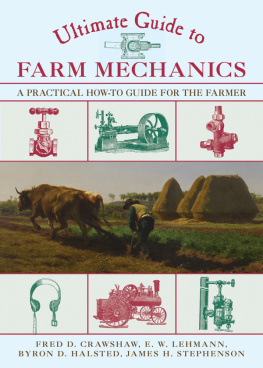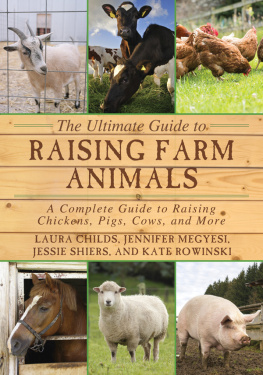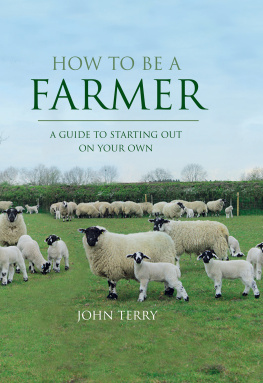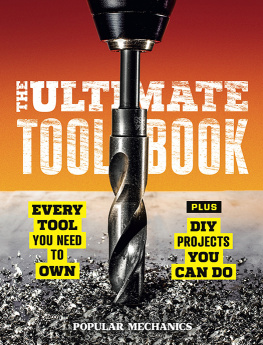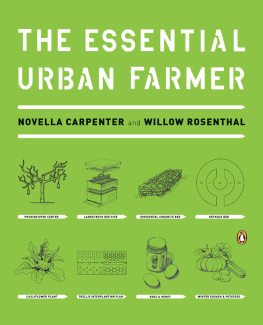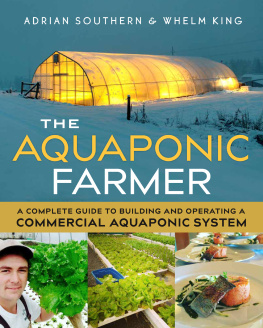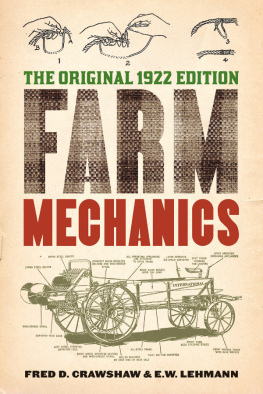Crawshaw Fred Duane - Ultimate guide to farm mechanics : a practical how-to guide for the farmer
Here you can read online Crawshaw Fred Duane - Ultimate guide to farm mechanics : a practical how-to guide for the farmer full text of the book (entire story) in english for free. Download pdf and epub, get meaning, cover and reviews about this ebook. year: 2015, publisher: Skyhorse Publishing, genre: Home and family. Description of the work, (preface) as well as reviews are available. Best literature library LitArk.com created for fans of good reading and offers a wide selection of genres:
Romance novel
Science fiction
Adventure
Detective
Science
History
Home and family
Prose
Art
Politics
Computer
Non-fiction
Religion
Business
Children
Humor
Choose a favorite category and find really read worthwhile books. Enjoy immersion in the world of imagination, feel the emotions of the characters or learn something new for yourself, make an fascinating discovery.
- Book:Ultimate guide to farm mechanics : a practical how-to guide for the farmer
- Author:
- Publisher:Skyhorse Publishing
- Genre:
- Year:2015
- Rating:3 / 5
- Favourites:Add to favourites
- Your mark:
- 60
- 1
- 2
- 3
- 4
- 5
Ultimate guide to farm mechanics : a practical how-to guide for the farmer: summary, description and annotation
We offer to read an annotation, description, summary or preface (depends on what the author of the book "Ultimate guide to farm mechanics : a practical how-to guide for the farmer" wrote himself). If you haven't found the necessary information about the book — write in the comments, we will try to find it.
Ultimate guide to farm mechanics : a practical how-to guide for the farmer — read online for free the complete book (whole text) full work
Below is the text of the book, divided by pages. System saving the place of the last page read, allows you to conveniently read the book "Ultimate guide to farm mechanics : a practical how-to guide for the farmer" online for free, without having to search again every time where you left off. Put a bookmark, and you can go to the page where you finished reading at any time.
Font size:
Interval:
Bookmark:


Copyright 2015 Skyhorse Publishing, Inc.
Farm Mechanics by Fred D. Crawshaw and E.W. Lehmann was first published 1922.
Farm Engines and How to Run Them by James H. Stephenson was first published in 1903.
Farm Conveniences and How to Make Them by Byron D. Halsted was first published in 1884.
All rights to any and all materials in copyright owned by the publisher are strictly reserved by the publisher. No part of this book may be reproduced in any manner without the express written consent of the publisher, except in the case of brief excerpts in critical reviews or articles. All inquiries should be addressed to Skyhorse Publishing, 307 West 36th Street, 11th Floor, New York, NY 10018.
Skyhorse Publishing books may be purchased in bulk at special discounts for sales promotion, corporate gifts, fund-raising, or educational purposes. Special editions can also be created to specifications. For details, contact the Special Sales Department, Skyhorse Publishing, 307 West 36th Street, 11th Floor, New York, NY 10018 or .
Skyhorse and Skyhorse Publishing are registered trademarks of Skyhorse Publishing, Inc., a Delaware corporation.
Visit our website at www.skyhorsepublishing.com.
10 9 8 7 6 5 4 3 2 1
Library of Congress Cataloging-in-Publication Data is available on file.
Cover design by Jane Sheppard
Print ISBN: 978-1-62914-445-0
Ebook ISBN: 978-1-63220-164-5
Printed in the United States of America
CONTENTS
BY F RED D. C RAWSHAW AND E. W. L EHMANN
BY J AMES H. S TEPHENSON
BY B YRON D. H ALSTED
FARM MECHANICS
by Fred D. Crawshaw and E. W. Lehmann
PREFACE
__________
THIS book has been prepared to meet the increasing need for a textbook on the mechanical processes commonly taught in agricultural high schools and colleges, and in industrial schools. Many teachers of vocational agriculture who find it difficult to organize suitable projects for their students will find that the exercises in this text have been worked out to meet their needs. The book should also be widely useful as a reference and instruction book on the farm.
The types of work covered, while primarily representing the common branches of mechanical activity required under rural conditions, are, in most cases, applicable to the requirements of the industry upon which each type has a bearing.
Each part of the book deals exclusively and comprehensively with one particular type of work, as woodwork, cement work, forging, etc.; a fact which should contribute to its usefulness, both as a text and as a reference book. Thru further divisions into chapters and numbered topics, a greater possibility of locating, at any time, the various details and descriptions is offered.
The treatment throughout the book is thoroughly practical. Emphasis is placed upon the proper use of tools and materials in their application to projects. The projects are selected from the standpoint of the practical application to the needs of the student. The gradation of projects within each of the parts has been kept in mind. The plan has been to treat each topic in such detail that the teacher who has a variety of mechanical work going on in his classes at one time may be largely relieved of the burden of class instruction, and can devote his energies to the needs of the individual pupil. Working drawings and specifications for many of the projects have been given. Each of these projects is analyzed into its sequential operations with numerous references to the previous projects for specific details. Many supplementary projects are provided.
The authors are indebted to their many friends who have given freely of their material and advice. They wish particularly to acknowledge the use of material furnished by the University of Illinois, the University of Missouri, the Iowa State College, the Portland Cement Association, and of cuts furnished by several trade journals and taken from state bulletins.
F RED D. C RAWSHAW .
E. W. L EHMANN .
CONTENTS
PART I
W OODWORKING
PART II
C EMENT AND C ONCRETE
PART III
B LACKSMITHING
PART IV
S HEET -M ETALWORK
PART V
F ARM M ACHINERY R EPAIR AND A DJUSTMENT
PART VI
B ELTS AND B ELTING
PART VII
F ARM H OME L IGHTING AND S ANITARY E QUIPMENT
PART VIII
R OPE AND H ARNESS W ORK ON THE F ARM
PART I
W OODWORKING
CHAPTER I
T REES AND L UMBER
1. Logging. The student is familiar with wood in two forms. One is logs and the other is lumber. It is not only desirable as information that you know the common trees, but it is necessary for practical purposes that you know different kinds of wood when you see them in boards.
Timber is first spotted by men who go thru the forest to mark with an ax those trees which are to be cut. It is then felled (chopped or sawed down) and trimmed by having all limbs cut off. The body, or trunk, of the tree and the limbs which are large enough to be sawed into boards are cut to board lengths of twelve, fourteen, or sixteen feet, etc., forming logs. These logs are rolled, hauled or skidded into a clearing to be piled up, measured and later transported to a saw-mill.
While in large piles in the clearing, which is an open space in the woods where the logs are said to be banked, they are scaled. This is measuring and estimating the number of board feet in each log. Each end of the log is measured and marked with the owners number.
The banking ground is frequently near a river and on a level above that of the water in the river, so that the logs can easily be rolled down into the stream, where they are allowed to drift to some point down stream, to be collected in a bog, or set-back, near a mill, and then to be sorted and later run into the mill and sawed into lumber. In case it is not possible to transport logs in the natural way, as just described, they must be hauled by team or train to the mill.
This description is very brief and is designed merely to give the outstanding facts in the process of felling trees and conveying them cut up to the mill. The reader is referred to Noyes Handwork in Wood , published by The Manual Arts Press, Peoria, Illinois, for an adequate description of this process and for a bibliography on logging.
2. Milling. The logs are conveyed from the mill pond or yard into the mill by means of an endless chain and the jack ladder which is an inclined platform running from the mill into the water of the mill yard. The endless chain which runs over this inclined platform is fitted with studs which engage with the logs as they are directed toward the jack ladder by men with long spiked poles. The logs are carried end to end into the mill and there are inspected for stones which may be lodged in the bark. A flipper, controlled by steam, throws each log to the side when the operator of the machine throws a lever. The log now rolls down an inclined plane to a stop made of heavy iron which is located at the edge of the saw table. When the operator of the saw wants a log, he releases the stop. This operation permits one log to roll onto the saw table, where it is dogged, or clamped, to the table.
The saw table moves backward and forward. With each passage of the table, a large circular, or band, saw cuts off a board. When two or three boards have been removed from the side, the log is turned completely over and a similar operation is performed on the opposite side.
By easily-controlled machinery, the log is revolved or moved into different positions to be sawed into boards. It is sent from the saw to the edger and the cross-cut, or butting, saw on live rollers which revolve on a horizontal table and transmit the boards at a rate of 200 to 250 feet per minute from one place to another. Finally, the boards, now known as lumber, are transferred to a shed, where they are sorted as to size, quality and cut, and then again transferred out of doors to be piled for air-seasoning until sold for construction purposes.
Font size:
Interval:
Bookmark:
Similar books «Ultimate guide to farm mechanics : a practical how-to guide for the farmer»
Look at similar books to Ultimate guide to farm mechanics : a practical how-to guide for the farmer. We have selected literature similar in name and meaning in the hope of providing readers with more options to find new, interesting, not yet read works.
Discussion, reviews of the book Ultimate guide to farm mechanics : a practical how-to guide for the farmer and just readers' own opinions. Leave your comments, write what you think about the work, its meaning or the main characters. Specify what exactly you liked and what you didn't like, and why you think so.

